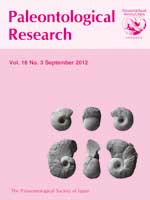Azooxanthellate coral species obtain nutrients by themselves, retaining their colonial growth forms independently of other species. This study examines the regularity of budding in the bushy, azooxanthellate scleractinian oculinid Cyathelia axillaris in order to identify the developmental constraints on colony formation and the ecological significance of colonial forms. The sympodial form of C. axillaris develops its bushy morphology by repeated dichotomous branching without clear axial corallites. The regularities in budding process are as follows: (1) in most cases, two buds originate simultaneously on opposite sides of medially constricted corallites near two parental second-order septa at individual distal ends; (2) the two directive septa of lateral corallites are oriented almost perpendicular to the directive septa of the immediate parental corallites; (3) the lateral corallites grow more or less diagonally upwards; and (4) these regularities remain valid from parental to derived lateral corallites throughout growth. Thus, apparently complex, threedimensional colonies with numerous offsets are formed according to certain rules, irrespective of the generation of individual corallites. The strict developmental constraints and the subtle modifications on asexual reproduction greatly affect the colonial growth that is unique to C. axillaris, for which the regularities in budding are effective and adaptive ways of utilizing limited resources (i.e., growth spaces and nutrients).
How to translate text using browser tools
1 September 2012
Regularity in Budding Mode and Resultant Growth Morphology of the Azooxanthellate Colonial Scleractinian Cyathelia axillaris: Effective and Adaptive Ways of Utilizing Habitat Resources
Asuka Sentoku,
Yoichi Ezaki
ACCESS THE FULL ARTICLE

Paleontological Research
Vol. 16 • No. 3
September 2012
Vol. 16 • No. 3
September 2012
asexual reproduction
azooxanthellate coral
budding
colony
Cyathelia axillaris




